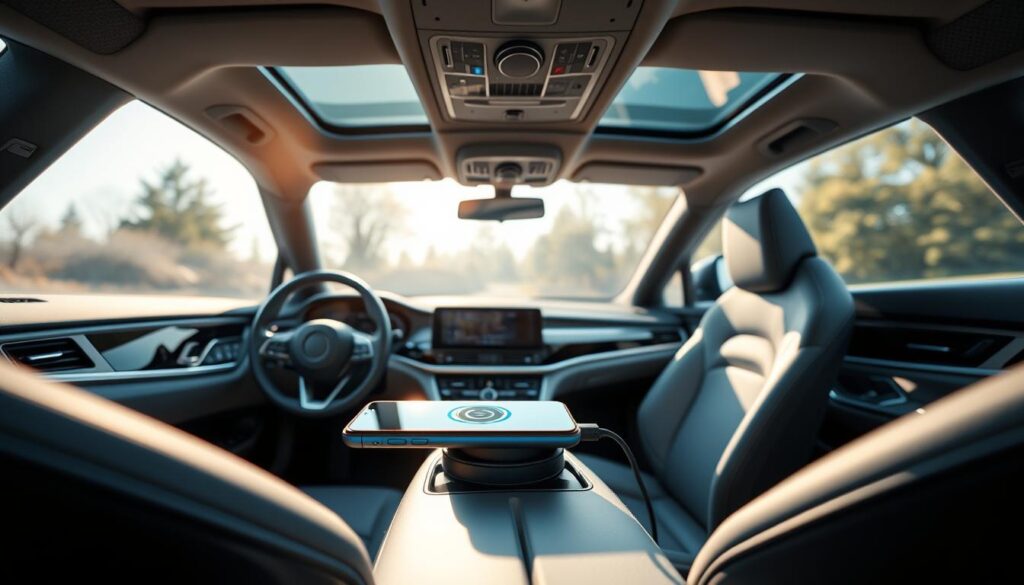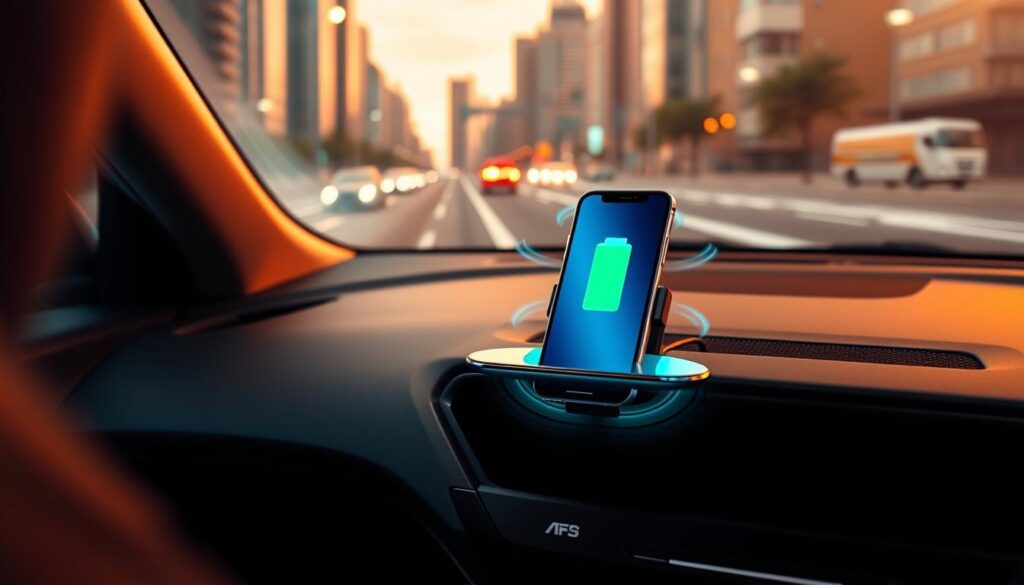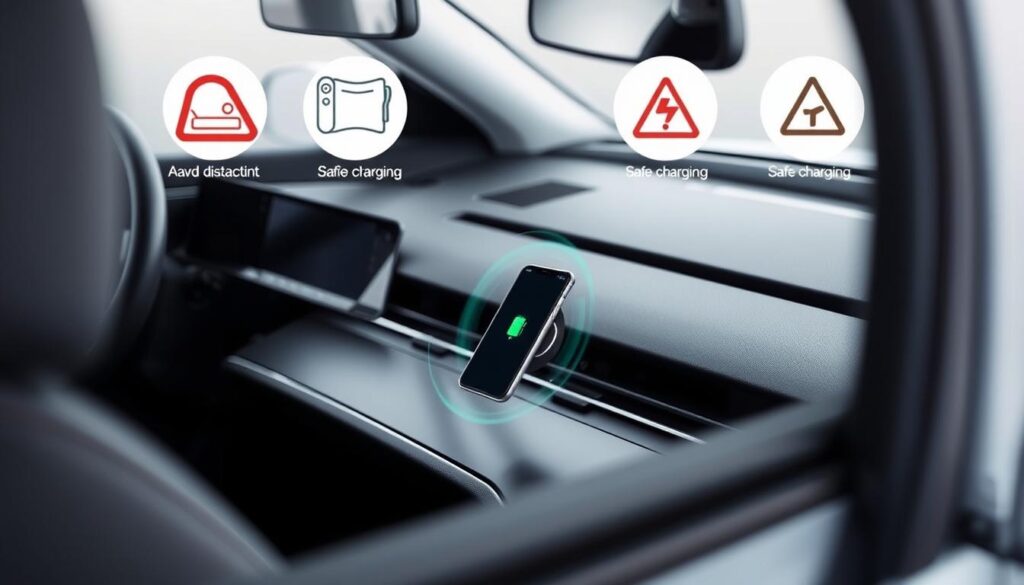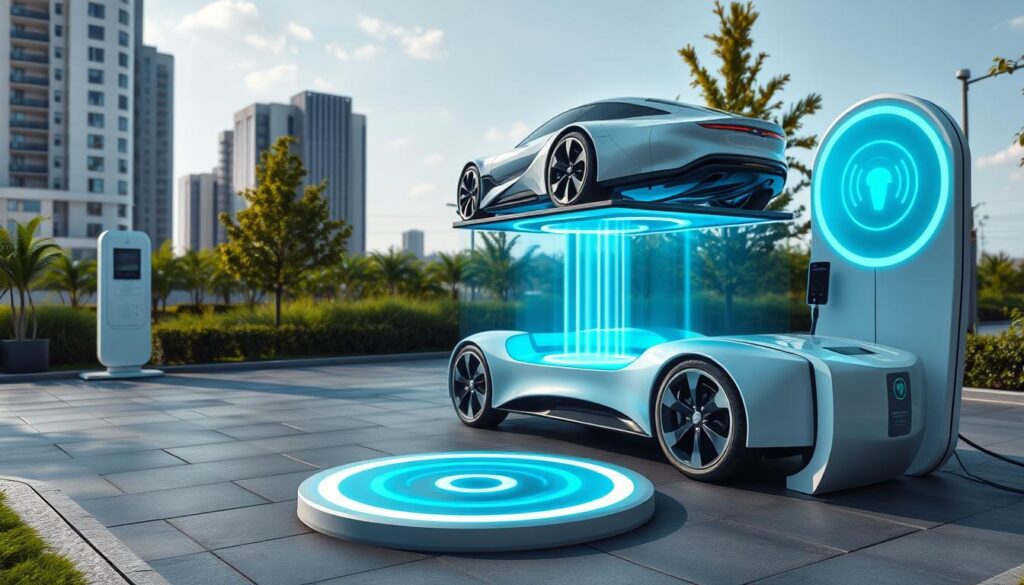Wireless car chargers are now a top choice for drivers. They offer a safe and easy way to charge phones on the go. This tech uses inductive charging, so you don’t need cables.
A good wireless car charger can also help you stay focused on the road. It lets you use your phone for navigation and music without distraction.

When picking a wireless car charger, look at a few things. Make sure it’s Qi Certified for compatibility. Also, check if it has adjustable mounts for better viewing angles.
Many phones, like iPhones and Samsung Galaxies, work with Qi technology. So, it’s key to find a charger that fits your phone.
Key Takeaways
- Wireless car chargers use inductive charging to transfer energy from the charger to your phone.
- A good car phone mount with wireless charging capabilities can reduce driver distraction.
- Qi Certification by Wireless Power Consortium (WPC) ensures compatibility with Qi-enabled devices.
- Adjustable mount features and 360˚ adjustable designs provide flexible viewing options.
- Compatibility with numerous Qi-enabled devices, including iPhone and Samsung Galaxy models.
- Wireless charging mounts generally charge phones at a maximum of 10 W.
- Research indicates that a good smartphone car mount can reduce driver distraction while allowing for easy access to necessary functionalities.
What Is a Car Wireless Car Charger?
A car wireless car charger lets you charge your phone while driving without cables. It uses the Qi standard for inductive charging. This makes charging safe and efficient. Many also have a magnetic mounting system for easy phone attachment and detachment.
The iOttie Easy One Touch Wireless 2 is a well-known example. It uses the Qi standard and has a magnetic mountingsystem. It’s a convenient way to charge your phone while driving. It also has an extendable neck and 360-degree rotation for different phone sizes.
Basic Operating Principles
Wireless car chargers work by inductive charging. A coil in the charger creates an electrical current in the phone’s battery. This is thanks to the Qi standard, which ensures compatibility and safety. The magnetic mounting system makes attaching and detaching your phone easy.
Key Components
A wireless car charger has a charging coil, magnetic mounting system, and power source. The charging coil creates the electrical current in the phone’s battery. The magnetic mounting system holds the phone in place. The power source connects to the vehicle’s 12-volt outlet.

How It Differs from Traditional Chargers
Wireless car chargers don’t need a physical connection to the phone. This makes them more convenient and clutter-free. But, they charge slower than traditional chargers, at about 10 watts. Despite this, they are a safe and efficient choice for drivers.
Benefits of Using a Wireless Car Charger
Wireless car chargers bring many benefits, like fast charging and convenience. They help keep your car tidy by eliminating clutter. You can charge your phone quickly, perfect for long trips or daily drives.
Some key benefits include:
- Fast charging, like BoostCharge Pro with Official MagSafe Charging at 15W
- Convenience, with easy setup and no cables
- Clutter-free, keeping your car neat
These chargers also have safety features. They protect against overheating, foreign objects, and overcharging. They’re easy to use, with no tools needed.

Wireless car chargers are super convenient. They let you charge your phone without cables. This is great for those always on the move. With fast charging, your phone’s battery can quickly get a boost, even on short drives.
Understanding Wireless Charging Technology
Wireless charging is getting more popular. It lets you charge your device without cables. This makes it easy and convenient. The Qi standard ensures it’s safe and efficient.
Safety features in wireless car chargers include overcharging protection and foreign object detection. These features prevent accidents and ensure safe charging. Most wireless car chargers can deliver up to 15W of power, perfect for fast charging.
Qi Standard Explained
The Qi standard is key for inductive charging. It’s used in many wireless car chargers. It makes sure devices charge safely and efficiently, working with many devices.
Power Output Specifications
Wireless car chargers can deliver up to 15W of power. This is great for fast charging. It means devices can charge quickly and efficiently.
Safety Features
Wireless car chargers have safety features like overcharging protection and foreign object detection. These features prevent accidents and ensure safe charging. They give users peace of mind.

- The global wireless electric vehicle (EV) charging systems market is projected to exceed $825 million by 2027.
- Most EV plugs have efficiency ratings between 80-95%.
- WiTricity’s wireless EV chargers achieve efficiency ratings of 90-93%.
| Company | Wireless Charging Technology | Efficiency Rating |
|---|---|---|
| WiTricity | Wireless EV chargers | 90-93% |
| Powermat | Inductive wireless charging | Up to 15W |
Essential Features to Look For
When picking a wireless car charger, look for a few key things. A strong car phone mount is essential. It keeps your phone safe and steady while you drive. Also, a magnetic mounting system is great. It makes attaching and detaching your phone easy.
When choosing, think about if it fits your phone and car. Also, check for extra features like cooling systems or adjustable arms. Here are some important features to look for:
- A sturdy car phone mount to keep your phone secure
- A magnetic mounting system for easy phone attachment and detachment
- Compatibility with your phone and vehicle
- Additional features, such as built-in cooling systems or adjustable arms
Think about the best mounting option for you. Options include dashboard mounts and air vent clips.

By looking at these features, you can find a wireless car charger that suits you. It will charge your phone safely and conveniently. With a strong mount and magnetic system, you can drive confidently, knowing your phone is secure and charging well.
Compatibility Guide for Your Vehicle
Choosing a wireless car charger means checking if it fits your phone and car. Make sure the charger works with your phone and car’s power system before buying. This step can prevent problems or damage.
To charge your phone without a hitch, think about these points:
- Phone model compatibility: See if your phone can charge wirelessly and if it fits with the charger.
- Vehicle requirements: Check if your car’s power system and ignition settings support wireless charging.
- Power system compatibility: Make sure the charger’s power matches what your phone needs to charge.
Some cars, like certain Chevrolet models, come with wireless charging built-in. But, always check your car and charger specs for the best fit. The charging pad might be in the center console or on the armrest.

Also, think about your device’s size and the charger’s capacity. Big devices like tablets might not fit, and small ones might move around. By matching your phone and car’s needs, you get easy and safe wireless charging on the move.
Installation and Setup Process
Setting up a wireless car charger is easy. Most chargers come with a suction cup or adhesive mount. You can attach it to your dashboard or windshield. Always follow the manufacturer’s instructions for the best results.
The setup includes a charger mount, an air vent clip, and a USB cable. Compatibility is key. The charger must work with phones that charge at different rates, like 15W, 10W, 7.5W, or 5W.
Here’s how to install and set up your wireless car charger:
- Attach the charger mount to the dashboard or windshield
- Connect the USB cable to the power source
- Adjust the charger’s arms to fit your phone
- Test the charger to ensure it’s working properly

The steps might change based on your device and car. But with the right parts and a bit of time, you’ll enjoy wireless charging on the move.
| Component | Description |
|---|---|
| Charger Mount | Attaches to the dashboard or windshield |
| Air Vent Clip | Provides an alternative mounting option |
| USB Cable | Connects the charger to the power source |
Optimal Placement in Your Vehicle
Choosing the right spot for a wireless car charger is key. It should be easy to use and see. Dashboard mounting optionsand air vent installation are top picks. They make it simple to get to your charger and see it.
Think about these points when picking a spot for your wireless car charger:
- Visibility: Make sure you can see the charger to check if it’s working.
- Accessibility: Pick a spot where you can easily put your phone in and take it out.
- Obstructions: Stay away from places that might block the charger’s signal.
A good spot for your wireless car charger makes driving better. It keeps your phone charged and handy. Whether you choose dashboard mounting or air vent installation, pick a spot that’s easy to use and doesn’t block your view.

| Installation Method | Advantages | Disadvantages |
|---|---|---|
| Dashboard Mounting | Easy access, high visibility | May obstruct view, require additional hardware |
| Air Vent Installation | Convenient, does not obstruct view | May not be compatible with all vehicles, limited adjustability |
Maintaining Your Car Wireless Car Charger
Regular maintenance is key to keeping your car wireless car charger in top shape. Check it for wear or damage and follow the maker’s troubleshooting and repair tips.
To keep your charger working well, do routine checks. Just make sure it’s securely in its bracket and there’s nothing blocking the charging area.
Important maintenance points include:
- Regularly clean the charger and around it to avoid dust
- Look for firmware updates for the latest features and security
- Watch how the charger works and adjust its position for better charging
By sticking to these easy maintenance and troubleshooting tips, you can make your car wireless car charger last longer. It will keep charging your devices efficiently and reliably.

| Charger Specification | Description |
|---|---|
| Maximum Charging Power | 15W |
| Charging Efficiency | ≤80% |
| Maximum Thickness of Phone Cases Supported | 4mm |
Troubleshooting Common Issues
Using a wireless car charger can sometimes lead to problems like slow charging and connection issues. To fix these, it’s key to follow the maker’s guide for troubleshooting. This might mean resetting the device or looking up troubleshootingtips in the user manual.
Some common problems include damaged charging cables, dust or debris in charging ports, and software glitches. Using top-notch charging cables can cut down charging problems by half. Also, keeping your software up to date can boost charging efficiency by about 25%.
Fixing these issues is often simple. For instance, if charging is slow, it might be because of the USB port type. USB-C chargers can charge faster, with up to 20 volts and 5 amps. Yet, wireless chargers usually charge slower than wired ones.

To speed up charging, try a different USB port or get a better wireless charger. By following these steps, you can make charging with your wireless car charger smooth and efficient.
| Issue | Solution |
|---|---|
| Slow charging speed | Use a different USB port or invest in a high-quality wireless charger |
| Connection issues | Reset the device or consult the user manual for troubleshooting guides |
| Damaged charging cables | Invest in high-quality charging cables |
Safety Considerations and Best Practices
Using a wireless car charger safely is key to avoid accidents or damage. About 90% of smartphone users need to charge their devices on the go. With wireless charging becoming more common, it’s important to follow best practices for safe and efficient charging.
Important safety tips include avoiding overcharging and keeping your device away from flammable materials. Always follow the manufacturer’s instructions for use and maintenance. It’s also important to pick a wireless car charger with safety features like overcurrent protection and temperature control to prevent fires and overheating.
Here are some best practices to keep in mind:
- Avoid overcharging your device, as this can lead to reduced battery lifespan and increased risk of overheating.
- Keep your wireless car charger away from flammable materials, such as fabrics or plastics.
- Follow the manufacturer’s instructions for use and maintenance to ensure safe and efficient charging.
- Choose a wireless car charger with built-in safety features, such as overcurrent protection and temperature regulation.

By following these safety tips and best practices, you can enjoy wireless car charging safely. Always prioritize safety and choose a reputable brand that follows industry standards and regulations.
Comparing Different Models and Brands
There are many wireless car chargers on the market. Each one has its own special features and prices. It’s important to look at these options carefully. Think about what you can afford and what features you need.
Models like the Tollefe 78W 5-in-1 and Spigen SteadiBoost are great for those on a budget. They offer lots of features at a low cost. But, if you want fast charging or wireless charging, you might need to spend more. The iOttie Auto Sense is a good example of this.
Here are some things to think about when comparing different models and brands:
- Power output and charge time
- Number of ports and compatibility
- Additional features like wireless charging and fast charging
- Price and value for money
By looking at these points, you can find the best wireless car charger for you. It should match your needs and budget.

Future of Wireless Car Charging Technology
The future of wireless car charging is looking bright. Future technology and wireless charging will change how we charge our cars. We’ll see better and easier ways to charge, like wireless charging on the move.
Big steps are being made in wireless charging. Imagine wireless roads and highways. This could ease the load on the grid. Companies like WiTricity are pushing for up to 96% connection efficiency.
Here are some benefits of wireless charging technology:
- Convenience: wireless charging means no more cords, making it safer and easier.
- Efficiency: It charges cars faster and uses less energy, saving time and money.
- Cost-effective: It makes charging cheaper, helping more people afford electric cars.

Looking ahead, future technology and wireless charging will shape the car world. We’ll see better, cheaper, and easier ways to charge. This will make electric cars even more appealing.
| Company | Technology | Efficiency |
|---|---|---|
| WiTricity | Wireless Charging | Up to 96% |
Conclusion
Wireless car chargers have changed how we charge our phones on the move. They make charging easy and clean, letting you charge your phone while driving. You don’t have to deal with messy cables anymore.
Looking at the benefits, features, and compatibility of different wireless car charger models helps you find the right one. This way, you can meet your needs and stay within your budget.
The need for smartphones in cars is growing fast. This means the wireless car charging market will get bigger soon. New tech and more cars with built-in charging pads will make these chargers even better.
Whether you want something affordable or a high-end model, there’s a lot to choose from. The market has many options to fit your style and budget.
To get the most out of your wireless car charging, make sure to install, maintain, and use it safely. This ensures a smooth and reliable charging experience. So, take your time to find the best wireless car charger for you.
With the right charger, your phone will always be ready to go. No matter where your journey takes you, your phone will stay charged.
FAQ
What is a wireless car charger?
A wireless car charger lets you charge your phone without cables. It’s perfect for driving, keeping your car tidy.
How does a wireless car charger work?
It uses the Qi standard for inductive charging. This means there’s a transmitter coil in the charger and a receiver in your phone. When your phone touches the charger, it starts to charge.
What are the benefits of using a wireless car charger?
It charges your phone quickly and easily. It also keeps your car tidy by removing cables. Plus, you can charge your phone without cables.
What is the Qi standard, and how does it work?
The Qi standard ensures your phone charges safely and efficiently. It sets rules for power output, charging distance, and safety. This makes charging reliable and consistent.
What features should I look for when choosing a wireless car charger?
Look for a sturdy mount and a magnetic system. Make sure it fits your phone and car. Also, consider extra features like cooling or adjustable arms.
How do I ensure my wireless car charger is compatible with my vehicle and phone?
Check the charger’s specs to match your phone and car. Look at phone model, charging power, and outlet compatibility.
How do I install and set up a wireless car charger?
Installation is easy. Just attach a suction cup or adhesive to your dashboard or windshield. Follow the instructions for the best setup.
Where is the best place to position a wireless car charger in my vehicle?
Choose a spot that’s easy to see and reach. Dashboards and air vents are good options. Make sure it’s not blocked.
How do I maintain and troubleshoot my wireless car charger?
Clean it regularly and follow the manufacturer’s troubleshooting tips. This helps it last longer and fixes problems like slow charging.
What safety considerations should I keep in mind when using a wireless car charger?
Follow the manufacturer’s safety guidelines. Avoid overcharging and keep it away from flammable things. Always prioritize safety.
How do I compare different wireless car charger models and brands?
Look at budget, features, and value. Compare specs, compatibility, and extra features. Find the best one for you.
What is the future of wireless car charging technology?
The future looks bright. Expect faster charging, longer battery life, and new charging methods. It will be more efficient and convenient.